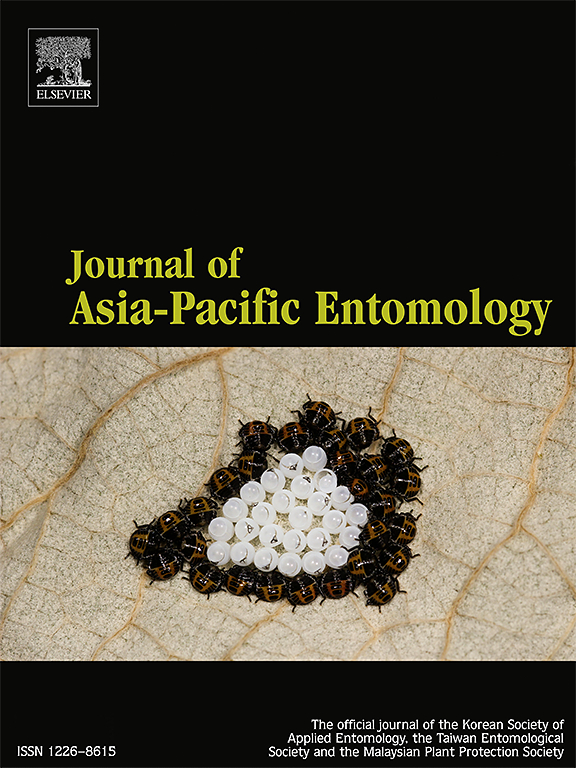高温诱导的转录组重塑损害家蚕胚胎的生存能力
IF 1.3
3区 农林科学
Q3 ENTOMOLOGY
引用次数: 0
摘要
适当温度下的酸处理可以同时防止蚕卵滞育和微孢子虫的传播。然而,家蚕卵中与过度热应激相关的转录特征尚不清楚,这限制了对这种双重目的处理的进一步研究。本文对比分析了两种温度对滞育终止的影响,提出47.5°C (T1)和48.5°C (T2)分别代表滞育终止的阈值和极端温度。此外,全长(FL)转录组被用于产生49,444个高置信度转录本,包括1,571个长链非编码rna (lncRNAs)。综合转录组分析显示,相对于T1处理,T2处理中有274个基因下调,255个基因上调,其中转录因子差异表达基因82个。值得注意的是,有23个Homeobox基因下调,5个bHLH基因上调。6个lncrna在T2和T1处理之间存在差异表达。功能富集分析表明,下调基因在基因表达调控和碳水化合物及重要氨基酸代谢方面显著富集。然而,上调的基因主要参与与热休克蛋白(HSPs)密切相关的通路,表明其在应激反应和分子伴侣中的保守功能。本研究全面揭示了极端热胁迫下家蚕卵的基因表达,为深入研究家蚕胚胎对过度热胁迫的反应以及有效控制病原菌与维持胚胎活力之间的平衡提供了宝贵的资源。本文章由计算机程序翻译,如有差异,请以英文原文为准。

Hyperthermia-induced transcriptome remodeling impairs embryo viability in Bombyx mori
Acid treatment at an appropriate temperature can simultaneously prevent egg diapause and microsporidian transmission in sericulture. However, the transcriptional features associated with excessive thermal stress in the eggs of Bombyx mori remain unclear, which limits further studies on this dual-purpose treatment. Here, we comparatively analyzed the effects of two temperatures and proposed that 47.5°C (T1) and 48.5°C (T2) represent threshold and extreme temperatures for diapause termination, respectively. Furthermore, the full-length (FL) transcriptome was used to produce 49,444 high-confidence transcripts, including 1,571 long non-coding RNAs (lncRNAs). Comprehensive transcriptome analysis showed that 274 downregulated and 255 upregulated genes were identified in the T2 treatment relative to the T1 counterpart, including 82 differentially expressed transcription factor genes. Noticeably, 23 downregulated Homeobox genes and 5 upregulated bHLH genes were detected. Six lncRNAs were differentially expressed between the T2 and T1 treatments. Functional enrichment analysis showed that the downregulated genes were significantly enriched in gene expression regulation and carbohydrate and important amino acid metabolism. However, upregulated genes were mainly involved in the pathways closely related to heat shock proteins (HSPs), indicating their conserved functions in stress responses and molecular chaperones. This study provides comprehensive insights on the genes expressed in B. mori eggs exposed to extreme thermal stress and provides a valuable resource for in-depth investigations of the response of embryos to excessive thermal stress and the balance between effective pathogen control and maintenance of embryo viability in silkworm.
求助全文
通过发布文献求助,成功后即可免费获取论文全文。
去求助
来源期刊

Journal of Asia-pacific Entomology
Agricultural and Biological Sciences-Insect Science
CiteScore
2.70
自引率
6.70%
发文量
152
审稿时长
69 days
期刊介绍:
The journal publishes original research papers, review articles and short communications in the basic and applied area concerning insects, mites or other arthropods and nematodes of economic importance in agriculture, forestry, industry, human and animal health, and natural resource and environment management, and is the official journal of the Korean Society of Applied Entomology and the Taiwan Entomological Society.
 求助内容:
求助内容: 应助结果提醒方式:
应助结果提醒方式:


